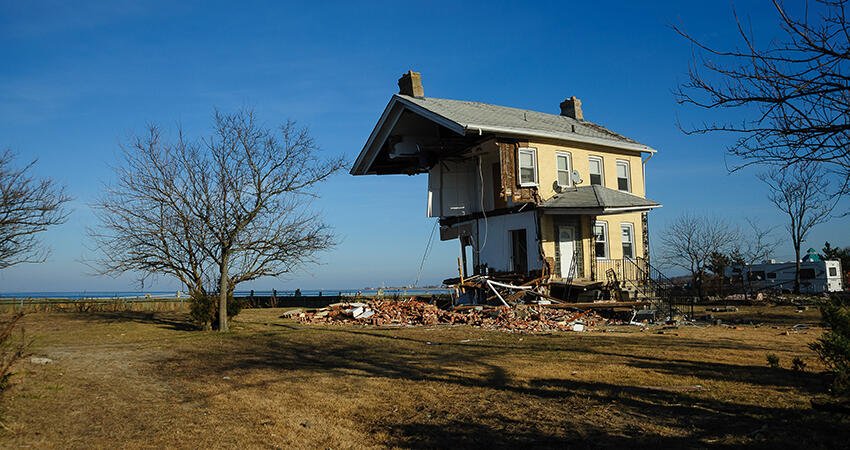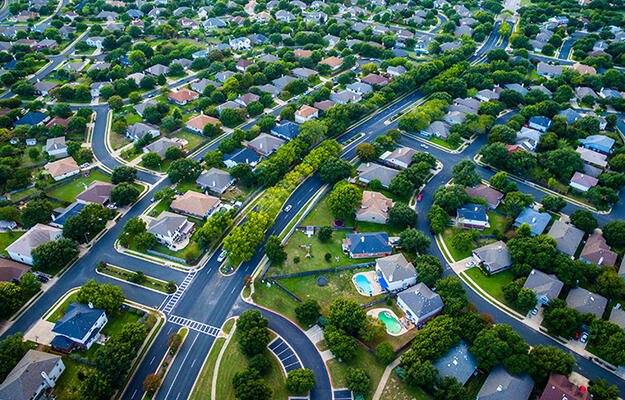
(Sky Cinema/Shutterstock)
Housing Approaches to Extreme Weather Can Lessen Harms to Community Health
Following the hottest year on record, 2023 also presented freezing weather. Last February, Mount Washington, New Hampshire, set a national record, with bone-chilling wind chill of 108 degrees below 0. The notable pattern of weather swings poses substantial risks to people, critical infrastructure, and community health. As extreme weather becomes more prominent, housing policymakers can reassess strategies and systems that address the challenges posed by climatic extremes.
Patricia Fabian is an associate professor at Boston University’s (BU’s) School of Public Health and associate director of BU’s Institute for Global Sustainability, where she focuses on community-engaged research that builds resilience to extreme heat.
In your research, you examine the health implications of extreme weather conditions. Could you elaborate on how both extreme heat and cold can impact individuals’ health?
We think about how heat and cold impact health in two ways: directly and indirectly. Directly has to do with physiology, so for example, extreme heat can cause heatstroke, heat exhaustion, and hyperthermia, extreme cold can cause hypothermia. Extreme temperatures can cause problems for people who are susceptible because of limited ability to thermoregulate, for example, developing young children, older adults, or people who have diseases like diabetes or chronic obstructive pulmonary disease. Another group to think about are people exposed to extreme temperatures at work, for example, construction workers.
Indirect health impacts happen because of limited ability to control extreme temperatures. In the case of cold weather and the needing to heat a home, residents who don’t have the ability to pay for their heating bills have to make decisions like “heat or eat” or “heat or rent.” Studies have shown that the resulting energy-insecurity problem has impacts on health, particularly in young children. And there are very few cooling policies. In Massachusetts, we have laws governing when landlords need to turn on the heat, but there are no regulations for providing or turning on cooling. There are cities and states that are starting to implement these, particularly hot states like Arizona. But we know from studies on environmental justice that if you have to turn on your AC, there are people who say, “I won’t turn on my air conditioner because I can’t pay for the electric bill,” or “I’ll turn on my fan instead of the air conditioner, because it’s too expensive to run it.” This creates the “cool or eat” or “cool or rent” problem, which is a similar situation to heating. It happens everywhere and is a growing problem in the northeastern and northern states that are traditionally colder.
Can you provide examples of how vulnerable communities are disproportionately affected by extreme weather, and what strategies can be employed to address these disparities?
Disparities happen at multiple levels: city, neighborhood, housing, and individual. These can also create combined vulnerabilities.
At a city level, there are urban heat islands. Studies have shown that communities of color and low-income households are disproportionately located in heat islands. These hot neighborhoods tend to be communities that have been disinvested in over time, potentially for reasons like redlining, but for other reasons as well. The result is a lack of trees, very densely built and crowded housing, and large areas of impervious surfaces that trap heat, all of which create heat islands. Our studies have shown a 7 degree difference between a neighborhood in Chelsea that has green space versus downtown, which has few trees.
At a housing level, housing quality matters. Is it weatherized and well insulated so you don’t have to pay high utility bills to keep it cool or warm in the winter? Do you actually have the power to make any changes to your house? Renters don’t necessarily have the decision power to weatherize or install solar panels or do anything that will help maintain temperature in the home to help with the utility bills. This speaks to the energy insecurity problem.
At the individual level, we know there are communities and populations disproportionately impacted: people of color, low-income residents, people with disabilities. At an individual level, having the ability to pay for and to have access to resources and quality housing matters.
From an individual to an industrial level, how can housing policies contribute to mitigating the impact of extreme weather on health?
Direct policies like a residential cooling policy that says cooling must be turned on by a certain date or that requires landlords to provide cooling for rentals are possible. But there are other indirect policies, like weatherization assistance programs, that were really about reducing energy consumption, and they link nicely to decarbonization policies. Decarbonization policies are about reducing greenhouse gas emissions, but with a broader holistic lens, they provide another opportunity for reducing energy bills, increasing the ability of residents to keep their homes thermally comfortable, with resulting impacts on health.
There are interventions and policies that can impact thermal comfort, such as decarbonization and net zero plans, painting roofs white, and installing solar panels, that are not thought of as a housing policy. Other examples are health interventions, such as doctors writing prescriptions for air conditioners. This already happens in Massachusetts and other places, but in an ad hoc way; there’s no uniform policy, no description of who would qualify or how it’s implemented. We need a holistic view and to be deliberate about what the impact is going to be on extreme cold, extreme heat, and health.
Are there novel aspects or considerations that haven’t been extensively covered, and how can communities and policymakers prepare for and address these emerging issues?
Emerging issues are compound climate risks. Instead of thinking just about flooding, and someone else thinking about heat, someone else thinking about cold, and someone else thinking about drought, climate hazards are happening in compounding ways. For example, if there’s a flood, followed by heat wave, that increases the risk of homes getting moldy, which necessitates a slightly different approach.
Another intersection is with chemical hazards. For example, Chelsea and East Boston store jet fuel at the banks of the Mystic River. There is also road salt for the 300+ Massachusetts cities and towns. Flooding is a big concern because of the potential for both environmental and resident impacts. Chemical and toxic risks are only starting to make it into climate conversation. These are the emerging issues we need to think about: climate hazards in conjunction, not in isolation, and linking with chemical hazards.
As I mentioned before, many climate and greenhouse gas emissions solutions impact housing and communities but aren’t deliberately framed as such. We need to look at climate adaptation, sustainability, and decarbonization and see them as opportunities for making communities more resilient.
What role can partnerships play in developing holistic solutions that address both the immediate and long-term challenges posed by extreme weather events on housing and public health?
You can’t do this without partnerships. It’s a nonstarter to think any one group of people has all the answers and solutions and can implement them. The C-Heat project has had some success because it leverages a collaboration between residents, BU researchers, Green Roots (an environmental justice organization), city sustainability staff and planning staff, and we also have an advisory board of all people and organizations from the community. This informs the research, solutions, and implementation. In our case, it’s been a partnership of city, community organizations, residents, scientists, and researchers. The one other partner really needed in this space is industry.


